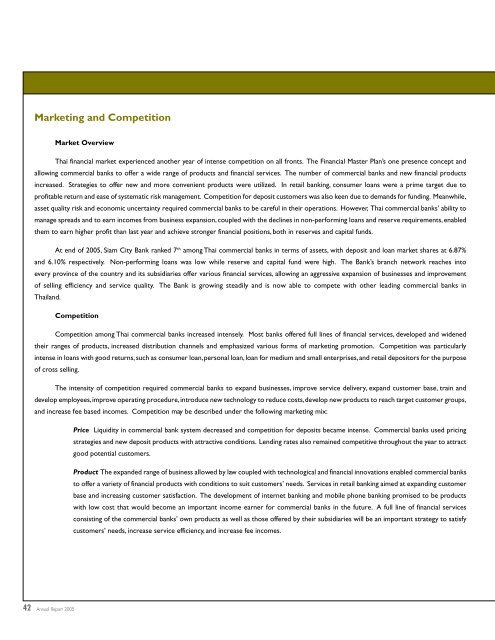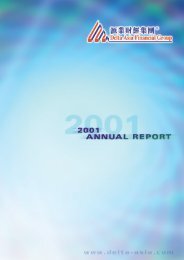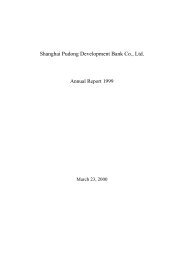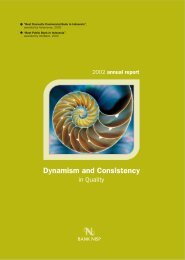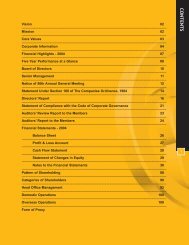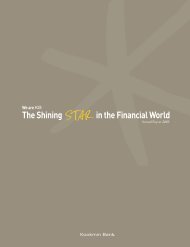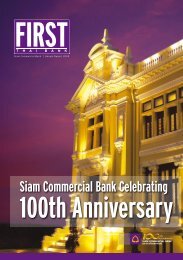2005 - Asianbanks.net
2005 - Asianbanks.net
2005 - Asianbanks.net
You also want an ePaper? Increase the reach of your titles
YUMPU automatically turns print PDFs into web optimized ePapers that Google loves.
Marketing and Competition<br />
Market Overview<br />
Thai financial market experienced another year of intense competition on all fronts. The Financial Master Plan’s one presence concept and<br />
allowing commercial banks to offer a wide range of products and financial services. The number of commercial banks and new financial products<br />
increased. Strategies to offer new and more convenient products were utilized. In retail banking, consumer loans were a prime target due to<br />
profitable return and ease of systematic risk management. Competition for deposit customers was also keen due to demands for funding. Meanwhile,<br />
asset quality risk and economic uncertainty required commercial banks to be careful in their operations. However, Thai commercial banks’ ability to<br />
manage spreads and to earn incomes from business expansion, coupled with the declines in non-performing loans and reserve requirements, enabled<br />
them to earn higher profit than last year and achieve stronger financial positions, both in reserves and capital funds.<br />
At end of <strong>2005</strong>, Siam City Bank ranked 7 th among Thai commercial banks in terms of assets, with deposit and loan market shares at 6.87%<br />
and 6.10% respectively. Non-performing loans was low while reserve and capital fund were high. The Bank’s branch <strong>net</strong>work reaches into<br />
every province of the country and its subsidiaries offer various financial services, allowing an aggressive expansion of businesses and improvement<br />
of selling efficiency and service quality. The Bank is growing steadily and is now able to compete with other leading commercial banks in<br />
Thailand.<br />
Competition<br />
Competition among Thai commercial banks increased intensely. Most banks offered full lines of financial services, developed and widened<br />
their ranges of products, increased distribution channels and emphasized various forms of marketing promotion. Competition was particularly<br />
intense in loans with good returns, such as consumer loan, personal loan, loan for medium and small enterprises, and retail depositors for the purpose<br />
of cross selling.<br />
The intensity of competition required commercial banks to expand businesses, improve service delivery, expand customer base, train and<br />
develop employees, improve operating procedure, introduce new technology to reduce costs, develop new products to reach target customer groups,<br />
and increase fee based incomes. Competition may be described under the following marketing mix:<br />
Price Liquidity in commercial bank system decreased and competition for deposits became intense. Commercial banks used pricing<br />
strategies and new deposit products with attractive conditions. Lending rates also remained competitive throughout the year to attract<br />
good potential customers.<br />
Product The expanded range of business allowed by law coupled with technological and financial innovations enabled commercial banks<br />
to offer a variety of financial products with conditions to suit customers’ needs. Services in retail banking aimed at expanding customer<br />
base and increasing customer satisfaction. The development of inter<strong>net</strong> banking and mobile phone banking promised to be products<br />
with low cost that would become an important income earner for commercial banks in the future. A full line of financial services<br />
consisting of the commercial banks’ own products as well as those offered by their subsidiaries will be an important strategy to satisfy<br />
customers’ needs, increase service efficiency, and increase fee incomes.<br />
42


